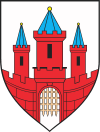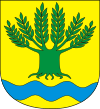Malbork
| Malbork | |||
|---|---|---|---|
|
City of Malbork | |||
| |||
 Malbork | |||
| Coordinates: 54°2′N 19°2′E / 54.033°N 19.033°E | |||
| Country |
| ||
| Voivodeship | Pomeranian | ||
| County | Malbork County | ||
| Gmina | Malbork (urban gmina) | ||
| Town rights | 1286 | ||
| Government | |||
| • Mayor | Marek Charzewski | ||
| Area | |||
| • Total | 17.15 km2 (6.62 sq mi) | ||
| Highest elevation | 30 m (100 ft) | ||
| Lowest elevation | 6 m (20 ft) | ||
| Population (2006) | |||
| • Total | 38,478 | ||
| • Density | 2,200/km2 (5,800/sq mi) | ||
| Time zone | CET (UTC+1) | ||
| • Summer (DST) | CEST (UTC+2) | ||
| Postal code | 82-200 to 82-210 | ||
| Area code(s) | +48 055 | ||
| Car plates | GMB | ||
| Website | http://www.malbork.pl | ||
Malbork [ˈmalbɔrk] (German: Marienburg (![]() listen); Kashubian: Malbórg; Latin: Civitas Beatae Virginis) is a town in northern Poland in the Żuławy region (Vistula delta), with 38,478 inhabitants (2006). Situated in the Pomeranian Voivodeship since 1999, it was previously assigned to Elbląg Voivodeship (1975–1998). It is the capital of Malbork County.
listen); Kashubian: Malbórg; Latin: Civitas Beatae Virginis) is a town in northern Poland in the Żuławy region (Vistula delta), with 38,478 inhabitants (2006). Situated in the Pomeranian Voivodeship since 1999, it was previously assigned to Elbląg Voivodeship (1975–1998). It is the capital of Malbork County.
Founded in the 13th century by the Knights of the Teutonic Order, the town is noted for its medieval Malbork Castle, built in the 13th Century as the Order's headquarters and of what later became known as Royal Prussia.
History of the castle

The town was built in Prussia around the fortress Ordensburg Marienburg, which was founded in 1274 on the east bank of the river Nogat by the Teutonic Knights. Both the castle and the town (named Marienburg in German and Malborg or Malbork in Polish) were named for their patron saint, the Virgin Mary. This fortified castle became the seat of the Teutonic Order and Europe's largest Gothic fortress. During the Thirteen Years' War, the castle of Marienburg was pawned by the Teutonic Order to their imperial soldiers from Bohemia. They sold the castle in 1457 to King Casimir IV of Poland in lieu of indemnities.[1][2]
Under continuous construction for nearly 230 years, the castle complex is actually three castles combined in one. A classic example of a medieval fortress, it is the world’s largest brick castle and one of the most impressive of its kind in Europe. The castle was in the process of being restored by the Germans when World War II broke out. During the war, the castle was over 50% destroyed. Restoration has been ongoing since the war. However, the main cathedral in the castle, fully restored just prior to the war and destroyed during the war, remains in its ruined state. The castle and its museum are listed as one of UNESCO's World Heritage Sites.
History of the town
The town of Marienburg grew in the vicinity of the castle. The river Nogat and flat terrain allowed easy access for barges a hundred kilometers from the sea. During Prussia's government by the Teutonic Knights, the Order collected tolls on river traffic and imposed a monopoly on the amber trade. The town later became a member of the Hanseatic League, and many Hanseatic meetings were held there.
The Teutonic Order weakened greatly after the Battle of Grunwald against advancing Poles and Lithuanians.[3] The Siege of Marienburg (1410) left the Teutonic Order in control only of the town, until it sold the castle and in 1457 transferred its seat to Königsberg (now Kaliningrad, Russia). The town of Marienburg, under Mayor Bartholomäus Blume and others, resisted the Poles for three further years. But when the Poles finally took control, Blume was hanged and quartered, and fourteen officers and three remaining Teutonic knights were thrown into dungeons, where they met a miserable end.[1] A monument to Blume was erected in 1864.[4]
The town became part of the Polish province of Royal Prussia after the Second Peace of Thorn (1466).[5] It was annexed by the Kingdom of Prussia in the First Partition of Poland in 1772 and became part of the Province of West Prussia the following year, which became part of the newly founded German Empire in 1871.

Under the terms of the Treaty of Versailles after World War I, the inhabitants were asked in a plebiscite on July 11, 1920 whether they wanted to remain in Germany or join newly re-established Poland. In the town of Marienburg, 9,641 votes were cast for Germany, 165 votes for Poland.[6] As a result, Marienburg was included in the Regierungsbezirk Marienwerder within the German Province of East Prussia. During the Weimar era, Marienburg was located at the tripoint between Poland, Germany and the Free State of Danzig.
The town was hit by an economic crisis following the end of World War I. After a brief recovery in the mid-1920s, the Great Depression was particularly severe in East Prussia. In January 1933, Hitler and the Nazi Party came to power and immediately began eliminating political opponents, so that in the last semi-free elections of March 1933, 54 of Marienburg's votes went to the Nazis.[7]). After the German invasion of Poland in September 1939, leaders of the Polish minority were arrested and sent to concentration camps.

_ID_636787.jpg)
During World War II a Focke-Wulf aircraft factory was set up at the airfield to the east of Marienburg. It was bombed twice by the USAAF in 1943 and 1944. Today the airfield belongs to the 22nd Air Base of the Polish Air Force.
Near the end of World War II, the city was declared a festung and most of the civilian population fled or were evacuated, with some 4,000 people opting to remain. In early 1945, Marienburg was the scene of fierce battles by the Nazis with the Red Army and was almost completely destroyed. The battle lasted until March 9, 1945.[8] Following the town's military capture by the Red Army, the remaining civilian population disappeared; 1,840 people remain missing. In June 1945, the town was turned over to Polish authorities who had arrived in the town in April and was permanently renamed Malbork.
Half a century later, in 1996, 178 corpses were found in a mass grave in Malbork; another 123 were found in 2005.[9] In October 2008, during excavations for the foundation of a new hotel in Malbork, a mass grave was found containing the remains of 2,116 people, a majority of whom were female. All the dead were said to have been German residents of pre-1945 Marienburg, but they could not be individually identified, nor could the cause of their deaths be definitely established. A Polish investigation concluded that the bodies, along with the remains of some dead animals, may have been buried to prevent the spread of typhus, which was extant in the turmoil at the end of World War II. On August 14, 2009, all the dead people’s remains were buried in a German military cemetery to the west of the town at Stare Czarnowo (German: Neumark) in Polish Pomerania, not far from the present-day German border.[10][11]
In Malbork one can also find a Commonwealth War Graves Commission cemetery [12] with 240 graves, mostly of POWs who died in the area during both wars, especially in the World War II Stalag XX-B camp.
After World War II, the town was gradually repopulated by Poles, many expelled from Polish areas annexed by the Soviet Union. In February 1946, the population of the town reached 10,017 people, then by 1965 grew further to 28,292 and by 1994 to 40,347.[13]
Also following the war, the Old Town in Malbork was not rebuilt; instead the bricks from its ruins were used to rebuild the oldest sections of Warsaw and Gdańsk.[13] As a result, with the exception of the Old Town Hall, two city gates and St. John's church, no pre-World War II buildings remain in the Old Town area.[13] In place of the old town, a housing estate was built in the 1960s.[13]
Notable residents
- Bartholomäus Blume (+1460 executed), mayor of the city of Marienburg
- Stibor de Poniec of Clan of Ostoja, Starost of Malbork 1460
- Achatius Cureus (1531–1594), author and lyricist
- Wilhelm von Schulte (1821–1894), cartographer and historian
- Adalbert Krüger (1832–1896), astronomer
- Bernhard Stadié (1833-1895), pastor and West-Prussian historian
- Carl Legien (1861–1920), leading politician of the Social Democratic Party of Germany
- Stanisław Taczak (1874–1960), general and commander-in-chief of the Great Poland Uprising; died in Malbork
- Bruno Kurowski (1879–1944), lawyer and politician
- Erich Kamke (1890–1961), mathematician
- Erich Abraham (1895–1971), general
- Heinz Galinski (1912–1992), president of the Central Council of Jews in Germany
- Alfred Struwe (1927–1998), actor
- Hartmut Boockmann (1934–1998), historian
- Klaus Ampler (1940-2016), cyclist
- Wolfgang Barthels (1940- ), soccer player
- Christel Lau (1944−), athlete
- Grzegorz Lato (born 1950), former striker for the Poland national football team
- Izabela Bełcik (born 1980), volleyball player
- Rafał Murawski (born 1981), soccer player
- Aneta Florczyk (born 1982), strongwoman
- Marcelina Zawadzka (born 1989), model, Miss Poland Universe 2012 and semifinalist at Miss Universe 2012
International relations
Twin towns — Sister cities
Malbork is twinned with:
|
References
- Notes
- 1 2 W.J. Watt The History of Prussia, pg 184-191
- ↑ Weber:Preussen in Ostmitteleuropa: Town of Marienburg resistance against Polish take-over
- ↑ Turnbull, Steven (2013). Tannenberg 1410: Disaster for the Teutonic Knights. Oxford, UK: Osprey Publishing. p. 21. ISBN 1472800095.
- ↑ Weber:Preussen in Ostmitteleuropa: Geschehensgeschichte und Verstehensgeschichte, 2003
- ↑ Stephen R. Turnbull, Peter Dennis, Crusader Castles of the Teutonic Knights, Osprey Publishing, 2003, p. 58, ISBN 1-84176-557-0, 9781841765570 Google Books
- ↑ marienburg.de
- ↑ "Deutsche Verwaltungsgeschichte Westpreußen, Kreis Marienburg". Verwaltungsgeschichte.de. Retrieved 2009-05-05.
- ↑ Berliner Zeitung 17 January 2009 "Das rätselhafte Massengrab"
- ↑ Der Spiegel "Mystery Surrounds Mass Graves in Polish City"
- ↑ NY Times Facing German Suffering, and Not Looking Away
- ↑ World War II Mass Grave Unearthed in Poland
- ↑ CWGC information for Malbork cemetery
- 1 2 3 4 Official town portal
External links
| Wikimedia Commons has media related to Malbork. |
| Wikivoyage has a travel guide for Malbork. |
- Municipal website (English)
- Malbork City Guide (English)
- Tourist Information
- Malbork portal (Polish)
- The Malbork Castle Museum
- The Malbork Castle Virtual Tour
- Photos of Malbork Castle, May'2007
- Photos of the Massgrave
- Accommodation and travelling in Malbork
Coordinates: 54°02′N 19°03′E / 54.033°N 19.050°E



